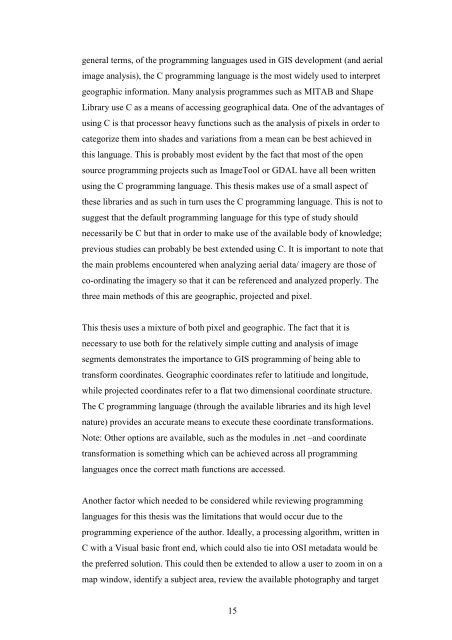Create successful ePaper yourself
Turn your PDF publications into a flip-book with our unique Google optimized e-Paper software.
general terms, of the programming languages used in GIS development (and aerial<br />
image analysis), the C programming language is the most widely used to interpret<br />
geographic information. Many analysis programmes such as MITAB and Shape<br />
Library use C as a means of accessing geographical data. One of the advantages of<br />
using C is that processor heavy functions such as the analysis of pixels in order to<br />
categorize them into shades and variations from a mean can be best achieved in<br />
this language. This is probably most evident by the fact that most of the open<br />
source programming projects such as ImageTool or GDAL have all been written<br />
using the C programming language. This thesis makes use of a small aspect of<br />
these libraries and as such in turn uses the C programming language. This is not to<br />
suggest that the default programming language for this type of study should<br />
necessarily be C but that in order to make use of the available body of knowledge;<br />
previous studies can probably be best extended using C. It is important to note that<br />
the main problems encountered when analyzing aerial data/ imagery are those of<br />
co-ordinating the imagery so that it can be referenced and analyzed properly. The<br />
three main methods of this are geographic, projected and pixel.<br />
This thesis uses a mixture of both pixel and geographic. The fact that it is<br />
necessary to use both for the relatively simple cutting and analysis of image<br />
segments demonstrates the importance to GIS programming of being able to<br />
transform coordinates. Geographic coordinates refer to latitiude and longitude,<br />
while projected coordinates refer to a flat two dimensional coordinate structure.<br />
The C programming language (through the available libraries and its high level<br />
nature) provides an accurate means to execute these coordinate transformations.<br />
Note: Other options are available, such as the modules in .net –and coordinate<br />
transformation is something which can be achieved across all programming<br />
languages once the correct math functions are accessed.<br />
Another factor which needed to be considered while reviewing programming<br />
languages for this thesis was the limitations that would occur due to the<br />
programming experience of the author. Ideally, a processing algorithm, written in<br />
C with a Visual basic front end, which could also tie into OSI metadata would be<br />
the preferred solution. This could then be extended to allow a user to zoom in on a<br />
map window, identify a subject area, review the available photography and target<br />
15
















